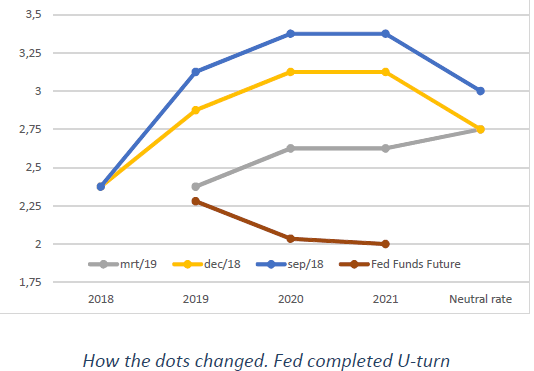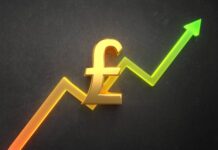- Muted inflationary pressures and economic headwinds cause patience
- Fed signals no more rate hikes in 2019
- Final rate hike in 2020; topping the cycle at 2.5%-2.75%?
- Balance sheet normalization ends at the end of September
- Lower US yields, softer dollar and confused stock markets
The Fed completed the U-turn it started at the turn of the year. The US central bank shelved all rate hike bets for the remainder of the year and pursues an end to its balance sheet run-off by September. Moreover, the new Fed projections pencil in only one more rate hike this cycle (2020). Patience is global central bank’s key word. Fed chair Powell seemed discouraged by the fact that the central bank didn’t achieve its 2% mandate “in a more symmetrical way”. One of the main drivers behind the Fed’s rigid pace of rate hikes last year was an expected inflation overshoot which didn’t materialize. Fed governors now want firm evidence of higher inflation before taking more action. Fed chair Powell opened the debate by stating that the US economy is in a “good place” and that he wants to keep it that way. Dark (international) clouds are piling up above the economy. Therefore, there’s no rush to act in “one direction or the other”. “It may be some time before the outlook for jobs and inflation calls clearly for a change in policy”.
In its new Summary of Economic Projections, the Fed downgraded growth and inflation forecasts. New median estimates suggest 2.1% growth this year (vs 2.3% in December), followed by 1.9% in 2020 (vs 2%) and 1.8% (unchanged) in 2021. The unemployment rate should remain below 4% in the 2019-2021 period, but at slightly higher levels that forecast in December. More importantly, the median estimate for the natural rate of unemployment (NAIRU) declined a notch from 4.4% to 4.3%. The Fed thus thinks that the economy can employ more people without having to risk higher inflation. The Fed’s policy statement showed several references to these somewhat more pessimistic forecasts. The US labour market remains strong, but little changed February payrolls get a special, and unusual, reference. Job gains are now labelled “solid” instead of “strong”. Both household spending and business fixed investment are categorized as showing slower growth. Back in December, the Fed said that only investment growth “had moderated”. Overall, growth of economic activity has slowed from its solid rate in the fourth quarter.
Headline PCE inflation forecast dropped from 1.9%, 2.1% and 2.1% (2019-2021) in December to 1.8%, 2% and 2%. Core PCE forecasts remain stable at 2% for the forecasting horizon, in line with the FOMC’s 2% inflation target. The Fed statement notes the energy prices induced decline of overall inflation and that market-based measures of inflation compensation have remained low in recent months.
No more rate hikes & end to BS run-off
The updated Fed dot plot mirrors the Fed’s wide-shared willingness to stay side-lined, at least for now. The median policy rate forecast for this year declined from 2.875% in December (2 hikes) to 2.375% in March (no hikes). Importantly, 11 out of 17 governors back this unchanged policy view, compared to only 2 out of 17 in December. The range of forecasts is also rather small with 4 governors taking into stride 1 rate hike and 2 hawkish members calling for 2 rate hikes. The 2020 median federal funds rate estimate dropped from 3.125% to 2.625%. That should be the final rate hike this cycle with also the 2021 median at 2.625%. Interestingly, 7 governors pencil in unchanged rates throughout 2020 and 5 members even throughout 2021. Again, the range of estimates is centred with 14 out of 17 Fed-members forecasting a policy rate below 3% in the 2020-2021 period. The median estimate for the neutral rate is unchanged at 2.75%, but two governors switched ranks (2.5% instead of 2.75%) compared to December. 6 out of 16 (St Louis Fed Bullard refuses to participate on this one) expect the neutral rate to be below the current median.
Apart from the dovish shift in the new dot plot, the Fed altered its balance sheet normalization principles and plans. The Fed intends to slow the pace of the decline of its balance sheet over coming quarters. The Fed currently lets $30bn in Treasuries and $20bn in MBS mature on a monthly basis without replacing them. The cap on monthly redemptions of US Treasuries will drop from the current level of $30bn to $15bn beginning in May 2019, before ending them altogether at the end of September. Beginning in October 2019, principal payments received from agency debt and agency MBS will be reinvested in Treasury securities subject to a maximum amount of $20 billion per month; any principal payments in excess of that maximum will continue to be reinvested in agency MBS. The share of US Treasuries in the Fed’s portfolio will thus start increasing from Q4 2019 onwards. The Fed’s balance sheet shrunk from over $4.5tn at the start of the run-off in Q4 2016 to below $4tn currently. By the end of September, we estimate it to be around $3.75tn. That’s way above original estimates of a decline towards levels in the area of $2.5tn
Market reaction
Markets were positioned for a soft message from the US central bank, but didn’t expect them to go that far. US yields lost 5.1 bps (30-yr) to 9.8 bps (5-yr) with the belly of the curve outperforming the wings. The US 10-yr yield fell to 2.53%, approaching key support around 2.49%. Short term rate markets continue to factor in an unchanged Fed policy rate this year, followed by a rate cut in 2020. The dollar was forced in the defensive, losing 0.66% on a tradeweighted basis. EUR/USD returned above the 1.14 mark. Given the weak fortunes of the single currency, we hold our view that a break above the 1.1571/1.1621 sideways upper trading band will be a tough nut to crack. US stock markets initially thrived on the news, but couldn’t maintain gains. Some investors see the Fed’s message as a strong hint that the end of the economic/monetary cycle is near













